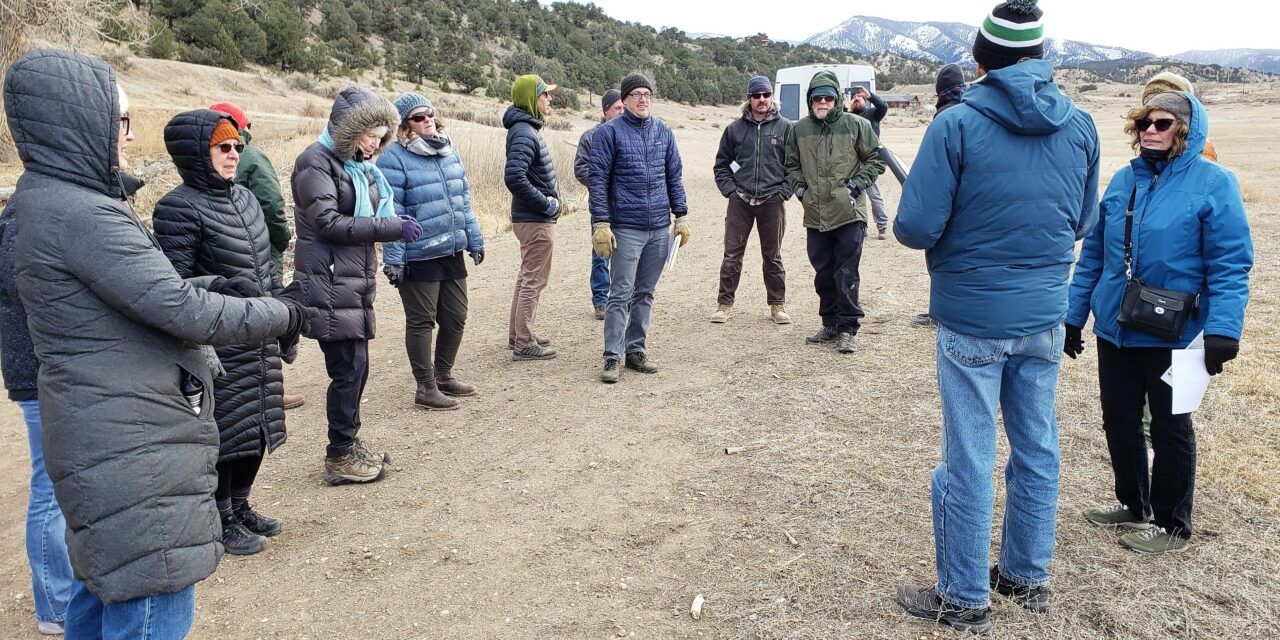Nearly 50 attendees, including the public, elected and appointed officials braved biting winds and cold on March 27, eager to see what might unfold at the proposed South Ark Neighborhood site. The approximately 100-acre parcel between U.S. 50 and CR 107 and CR 104 is the focus of a series of site tours and design charette workshops this week.
As reported by Ark Valley Voice, the week concludes with a presentation of preliminary design concepts, incorporating public input, from 5:30 p.m. to 7:30 p.m. on Thursday, March 30 at the Salida SteamPlant. The public is welcome and encouraged to attend at any point during the Thursday event to look at what fellow Salidans have come up with for ideas.
A Balancing Act: Housing, Recreation and More

South Ark Neighborhood Plan Natural Features Basemap. Flood plain and floodway shown in blue shading. Image courtesy City of Salida
City of Salida Community Development Director Bill Almquist and Parks and Recreation Director, Diesel Post led a series of four tours Monday and Tuesday, beginning each with a discussion of the challenges that the varying topographical contours and natural features there pose for planners and builders.
Areas not suitable for vertical development include the floodplain, steep slopes and natural springs, among others. Other major considerations include infrastructure: the cost of connector roads, water, wastewater, as well as electrical power. Regardless of who pays upfront for these, in the end, the costs will be felt variously by developers, renters, homeowners, and Salida taxpayers.
Before setting out to tour the site, Diesel Post provided an overview of how different types of parks, facilities, and open space provide various amenities, but also impact heavily on the amount of housing that might also be built. In addition to upfront recreation costs, consideration must be given to the ongoing labor required for safe operations, upkeep plus normal wear and tear.
“We need to come to terms with how do we manage open space,” Post said. “There’s a level of responsibility that comes with it. As a municipality, we have to consider public safety.”
Post then compared “Parks” as having standard expectations, whereas open space, by definition, is full of natural hazards (like fallen trees) and no set standards for what should be done for maintenance. He asked elected officials for their guidance with this.
Into the wind…
As the last tour group of the day left the warmth of the shuttle bus and began an hour’s clockwise walk of the entire property, the vast scale of it all became evident. Scrambling up wash areas and steep slopes through the Heart of the Rockies Disc Golf Course (which is planned to remain), snow-capped views to the south and west were commanding, with the property boundary lines hardly visible.
Almquist pointed out previously delineated wetland areas (which need to be updated) and that use of those areas requires special permits. Later on the tour, Post described how channels in the South Ark River have shifted over time, due to man-caused interventions as well as beaver activity and other natural forces. Even this early in the spring, the waters were running swiftly, with fallen tree limbs on both banks. It was noted that while people walk along the river’s edge, it poses hazards for children and pets.
High density maximizes housing while leaving land for recreation
Almquist then pointed out that, the best areas for housing development are those that are “higher and drier”, comprising some 30-40 acres. Speaking to recreation spaces, Post noted that Holman Field and the Kessner turf field are not owned by the City and the Salida Golf Course is currently leased out. “The City is literally out of space for recreation.” Other mountain communities have long had serious funding (via property, real estate transfer taxes, lodging taxes dedicated to recreation, and even recreation (taxing) districts) while Salida currently has only a sales tax. “The question is, will the community vote to go into debt to the tune of $20-30 million for a recreation center?” Post said.
Returning to housing, Almquist cited discussions with Colorado Mountain College (CMC) about possible partnerships that could provide mutual benefits. “They are building housing at every campus that they have. It’s an education program that services the population that is already there. It’s not traditional student housing (dorms) but workforce housing that their students would live in and as well as work in town.”
The South Ark Neighborhood Plan: what’s next?
As the 90-minute tour concluded, the participants came away with a much clearer vision of what they and the city’s consultants have to work with. The week’s activities now move into design workshops, hopefully involving stakeholders from all the individuals who have seen the site first-hand. Ark Valley Voice continues its coverage, next examining the structured process that aims to capture the best mix of recreation, housing and housing types, community, and other uses for the South Ark Neighborhood.
Featured image: Bill Almquist, Salida Community Development Director (back to camera) addresses Planning Commission and Salida City Council members at South Ark Neighborhood site tour, March 27, 2023. Merrell Bergin photo







Recent Comments